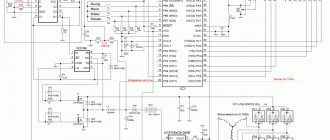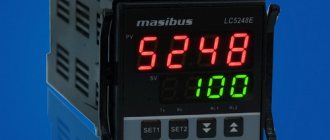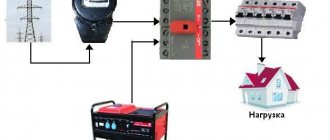A DIN rail is a special mounting strip placed in distribution cabinets and similar prefabricated structures. Its main purpose is to serve as a basis for mounting RCDs, circuit breakers and other protective devices serving the power supply line. A standard size DIN rail can accommodate several samples of devices of various classes, including powerful magnetic starters. It all depends on the specific width of the modular machine, determined by its functional purpose.
G-shaped
A less popular type of slats. The application is no different from the C-shaped one.
- The dimensions of the slats correspond to the GOS standard. The standards are as follows:
- The Ω-shaped rail, which is called TN-35, can also be of different sizes:
- The length of the slats can vary, most often it depends on the manufacturers. The length can start from 7 cm to 200 cm. A similar rail can be used to install a panel from 4 to 96 modules.
DIN rails are divided into two types according to the casting method. Slats made of continuous casting. Installing such a rail is a little labor-intensive, unlike the second type, but such a rail can withstand more load and can withstand many machine mounts in the cabinet.
The second type of slats provides holes that greatly simplify the method of attaching the slats to the surface. It is enough to screw the screw into the hole; the distance between the holes is 1-1.5 cm. This way you can securely fix it to the surface. But due to the presence of holes, the rail becomes less durable.
DIN rails are made from aluminum and stainless steel. To install electrical appliances, stainless steel slats are used.
For certain cases, slats of improved strength and depth are available for sale. Their use depends on the location and case of work.
There are various brands of slats on the shelves of hardware stores. The most popular, distinguished by their quality and price category, are the following manufacturers: ABB, IEK and DKS. You can find products that are suitable in quality and price.
Let's make a project
It is better for a non-professional to do this when all the wires have already been laid and all the circuits have been taken into account. At the development stage, we must create working drawings for ourselves, according to which subsequent work will be carried out, and also find suitable specifications for components and accessories.
Consumer accounting, group creation
You need to start by compiling a complete list of consumers, if this was not done during installation of the wiring. This will not include the iron or sconce in the hallway, but each wire coming to the switchboard, which must be recorded and designated with a number.
Residential power supply systems follow the same principles and are therefore similar to each other. The power sockets of each room are powered separately and the lighting of the rooms is separately powered. Some household appliances do not connect to junction boxes; their wires go directly to the panel. This is not always explained by their increased power, like that of an electric stove, for example. Isolation may be a consequence of increased protection requirements (the boiler must be connected through a very sensitive RCD), or the need to turn off the device locally (an air conditioner for maintenance).
Sockets for each room must be powered separately
So, here is a typical list for a modern three-room apartment:
- sockets in the bedroom;
- sockets in the living room;
- sockets in the nursery;
- sockets in the bathroom;
- sockets in the kitchen;
- sockets in the corridor and hallway;
- connecting a washing machine;
- boiler connection;
- air conditioner connection;
- connecting an electric stove;
- lighting in the bedroom;
- lighting in the living room;
- lighting in the nursery;
- lighting in the kitchen and bathroom;
- lighting in the corridor, hallway and balcony.
Of course, if each circuit is “put” on its own machine and run through an RCD, it will be both more reliable and more convenient. But issues of compactness and efficiency are also important. We can combine some of the circuits listed above if the load is moderate and separate automation is not needed. For example, points 1 and 2, combinations 11+12+13 and 14+15 are also possible.
After combining, we transform the list into a simple table, where we will then enter data on the ratings of machines and RCDs.
Din Rail Superiority
The din rail greatly simplifies the process of fastening electrical appliances, in turn, this allows you to equip switchboard rooms with more modern equipment.
- Modules for DIN rails are the same size, thereby greatly simplifying the mounting process. You can use one mounting device for different modules.
- Previously, panels with two plugs were used and attached; at present, such electrical panels are considered obsolete. Also, the methods of fastening them, fastening with nails, nuts, screws and other things are also considered obsolete.
Modern panels are much more compact, equipped with additional switches, zero busbars, protective busbars, and a working busbar, and additional equipment.
Assembling this structure will not cause you any difficulties. Using a DIN rail will also simplify the installation process. The modern shield fits harmoniously into the interior without attracting unnecessary attention.
Installing a circuit breaker is easy
Circuit breaker installation can be divided into three parts:
- DIN rail fastening;
- Installation of a circuit breaker;
- Connecting the circuit breaker.
DIN rail mounting
In a new electrical panel or electrical box, the DIN rail is attached to ready-made places using self-tapping screws or bolts.
To install a DIN rail in an old floor panel, you need:
- Drill two holes in the metal platform of the shield;
- Cut threads into them;
- Secure the DIN rail with two bolts.
In the new floor panels, special perforated racks are already installed for fastening DIN rails, and fastening the DIN rails is not difficult.
Circuit breaker installation
After installing the DIN rail, we proceed to installing the circuit breaker.
- Prepare the circuit breaker and a long screwdriver;
- Pull the latches down and slide the circuit breaker onto the DIN rail;
- Release the latch. It should catch on the DIN rail.
A three-phase circuit breaker is installed in a similar way.
Circuit breaker connection
- To connect the circuit breaker, unscrew the screws of the upper and lower terminals;
- Insert pre-protected wires into the clamps;
- Tighten the clamps firmly, but not too enthusiastically.
The household series of switching equipment has another name - modular. The reason for this is that all circuit breakers, switches, and RCDs are assembled from modules of the same width. Their overall dimensions are approximately the same.
An important property of the modular series equipment is that its mounting is unified. Let's remember how old circuit breakers were attached to the surface. To do this, it was necessary to drill holes, sometimes even cut threads into them. And also use fasteners: screws, nuts, washers. Not only is this inconvenient, but it is also unsafe. In an electrical panel, part of which is energized, replacing the circuit breaker is carried out with a certain degree of risk. A dropped screw can short-circuit a phase to the housing and cause a short circuit. And both an amateur and a professional electrician can drop it.
No screws are required to fasten electrical equipment of the modular series. All of them are installed on a standard metal strip. It's called a din rail, let's figure out what it is.
The abbreviation DIN comes from the abbreviation of the name of the German Institute for Standardization, Deutsches Institut fur Normund. Strictly speaking, this abbreviation is used not only to designate rails, it is used in other areas to mark standard connectors, fastener parameters, and so on.
Tires on rack
A bus on a din rail is necessary to combine the ground wire and the neutral wire. Can be used at voltages up to 400V.
The bus is a plastic structure equipped with a mechanism for mounting on a DIN rail. The design contains from 2 to 4 bronze bars, between which there is a transparent material. The design is protected from third-party influences by a transparent panel.
Feasibility of use, taking into account the advantages and disadvantages
First of all, let's look at the advantages of using a comb:
- The quality of switching is undeniable; contact with a branch wire is much more reliable than when using a solid wire as a jumper. Accordingly, overheating of the contact pad and numerous associated problems are practically eliminated.
- In most cases, comb buses for six modules or more are designed for a load of 63A (GOST R 50030.5.1-99). In order for the wire to withstand such a load, it must have a cross-section of at least 16mm2, which significantly complicates working with it.
- The number of wires in the panel is reduced, which is reflected in the accuracy of the wiring and its clarity. Accordingly, if necessary, dealing with it will not be difficult. To see this, just look at Figure 7.
Figure 7. If you use a comb, everyone can independently perform high-quality wiring. Of course, any solution has its weaknesses, in this case these include the following features:
- Problems often arise when trying to install protective devices from different brands. This may be due to the dimensions of the devices, different levels of contact pads and other differences in designs. As a result, it is not possible to connect different types of AVs with each other.
- Problems in case of repair. If you need to replace a failed device, you will need to loosen the fastenings on all bends, otherwise it will not be possible to remove the comb for dismantling.
- There are also problems with upgrading the shield. For example, when it becomes necessary to install an additional single-pole device, the busbar will need to be replaced, or an adapter jumper will be installed, which will negatively affect the quality of the contact.
- During repair work or modernization, it becomes necessary to de-energize all devices connected to the comb; in some cases this can cause problems.
- The cost of such a solution is much higher than using a jumper made of solid wire, especially when it comes to branded products.
Speaking about the feasibility of use, it should be noted that it makes no sense to use a comb to connect two to five devices. Since most manufacturers practically do not produce buses designed for less than 6 modules, they adhere to the same opinion.
DIN rail mount
This type of slats has specific edges turned outward. They serve as a place for fastening. Also, thanks to them, the structure can move without problems along the entire length of the rail.
If there is no need to move the structure, stoppers are installed along the edges of the fixed apparatus to prevent the structure from moving. Reliably fixing it in one position.
- In rare cases, small holes are made on the shield cover to facilitate fastening.
- Some devices have already installed fasteners to fix it on the rail.
- You must press the latch until it clicks, this way you secure the structure.
- Removing such a latch is not difficult; just use a flat screwdriver to bend the edge of the latch and the structure can be removed.
If you are installing electrical appliances on a DIN rail for the first time, you can turn to online resources and video clips with a detailed description. If you study carefully, installation will not take much time.
Calculation of module width
An example of the overall and installation dimensions of a machine.
The dimensions or dimensions of circuit breakers mounted on a DIN rail are usually calculated taking into account the following considerations:
- what is the total number of these devices planned to be installed in accordance with the wiring diagram used;
- what type of metering device (meter) and circuit breakers are supposed to be installed on it;
- what is the minimum gap between these devices that should be left.
If two automatic machines or RCDs can be mounted almost close to each other, the devices must be installed next to the electric meter at some distance (at least 1-2 centimeters).
When calculating the number of devices that can fit on a DIN rail, it is necessary to take into account their functional purpose. A two-pole circuit breaker has a larger width than a single-pole circuit breaker.
DIN rail selection
When choosing a rack, pay attention to the manufacturer. Choose from ABB, IEK and DKS. These manufacturers produce high-quality slats at an affordable price.
- DIN rail profile. The Ω-shaped rail, which is called TN-35, is suitable for installing various types of electrical panels. The design is easy to assemble.
- Length of the slats. Consider the size of the rail you will use to attach the modules. The rail must be taken according to the size of the electrical cabinet.
What does it look like?
A photo of a din rail clearly makes it clear that it is an elementary mounting strip - a profiled metal strip, cast or with specially made holes for fixing to the surface.
The name of the bar was the abbreviation of the developer of the useful device - the German Institute for Standardization or Deutsches Intitut for Normung - abbreviated as “DIN”. There are other variations of the name: lath, strip, rail, tire and profile.
Nowadays, mounting plates are so popular that almost all electrical equipment, even at the production stage, is equipped with special clamps for mounting on a din, greatly facilitating the work of electricians.
Strength
As previously mentioned, slats are made from various materials. Each of them has a load limit. When purchasing a slats, consider this factor. For heavy loads, stainless steel slats are suitable.
Aluminum slats can withstand different loads. The load is classified depending on the thickness of the slats.
- The thickness of the 1mm rail is suitable for fastening a single device that is light in weight.
- The 1.1mm rail thickness is intended for several modules.
- The thickness of the slats is 1.4mm-1.5mm and is particularly durable. Can be used for fastening massive devices, switches and high-power devices.
When choosing Din rails, carefully consider the choice of manufacturer, quality of material, strength and scope of application.
Kinds
And before moving on to the types, it is worth describing the differences that they may have. Mainly changed:
- weight;
- strength;
- the strength of the current carried through the terminals;
- material: steel and aluminum;
- perforation: continuous and regular;
- notch: either there or not.
And if we are talking about standards, then you need to understand that it is impossible to unify the fasteners of electrical devices and rails. Therefore, there are three varieties used depending on the situation:
- Omega type. The most popular type and enshrined in Russian GOST, which is often referred to as TH35. Its width is 35 mm, although there is also a version on the market with a smaller format in thickness and width. Basically, such smaller versions are used for terminals, not devices. In addition to the material, there is also its processing, the most popular of which are anodizing, galvanizing and galvanizing.
- C-type. It has dimensions similar to Omega - 32 mm. The ends in this form are bent inward, which visually resembles the letter C. Mainly used for clamps and terminal blocks, however, there are a number of devices for which the C-type is also the most suitable.
- G-type. The model is identical to the C-type, with the exception of one difference - one of the ends is smaller and narrower than the other. Visual association with the letter G. Also used for clamps, but the difference in shape is necessary for flexibility in installation in inaccessible places and specific equipment.
If you need to install a terminal, then the omega type is often useful. All the rest are mostly used by builders. If you make repairs, you will have to either choose the slats responsibly from the beginning, or get advice from experienced builders.
Photo DIN rails
Share with friends











